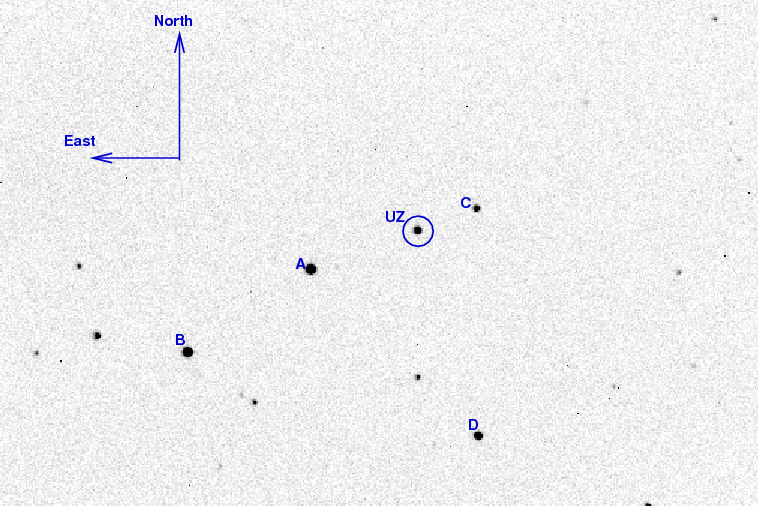
On the night of Aug 03/04, 2013, I observed SN 2013ej in M74, as well as the cataclysmic variable star UZ Boo. I also used the Landolt standard field PG 2213-006 to measure the color terms for our 12-inch telescope and filters.
The main setup was:
Notes from the night
The cataclysmic variable star UZ Boo is currently in outburst. Below is an image from UT Jul 26, 2013 observations. .

Using aperture photometry with a radius of 4 pixels (radius of 7.4 arcsec), I measured the instrumental magnitudes of a number of reference stars and the target. Following the procedures outlined by Kent Honeycutt's article on inhomogeneous ensemble photometry, I used all stars available in each image to define a reference frame, and measured each star against this frame. I used the AAVSO's V-band magnitude for star "A", V = 11.094, taken from their chart 12447AMF, to convert the ensemble instrumental magnitudes to the standard V-band scale.
The graph below shows the change in zeropoint from image to image.
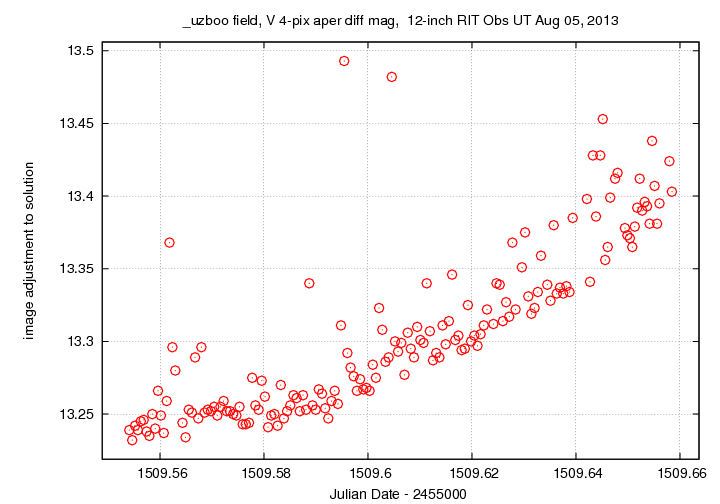
The scatter as a function of instrumental magnitude shows that the brightest unsaturated stars had a scatter of about 0.005 mag. The target, at instrumental magnitude 2.2, has a scatter of 0.029 mag, which is barely elevated above the locus of non-variable stars.
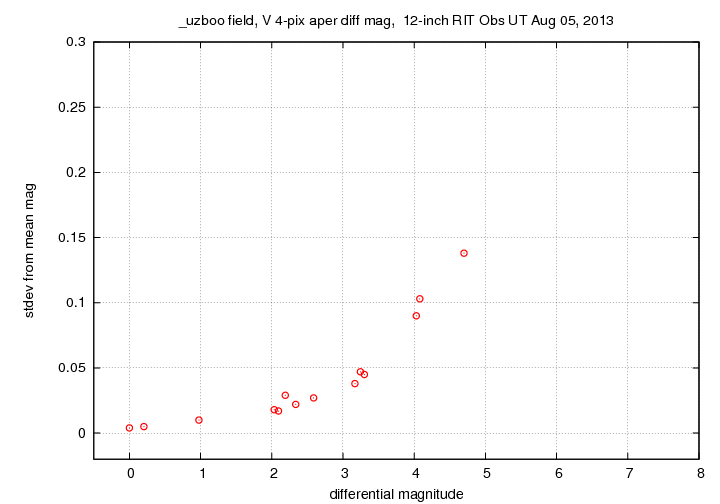
Here are light curves of the target star (green crosses) and some of the other stars in the field.
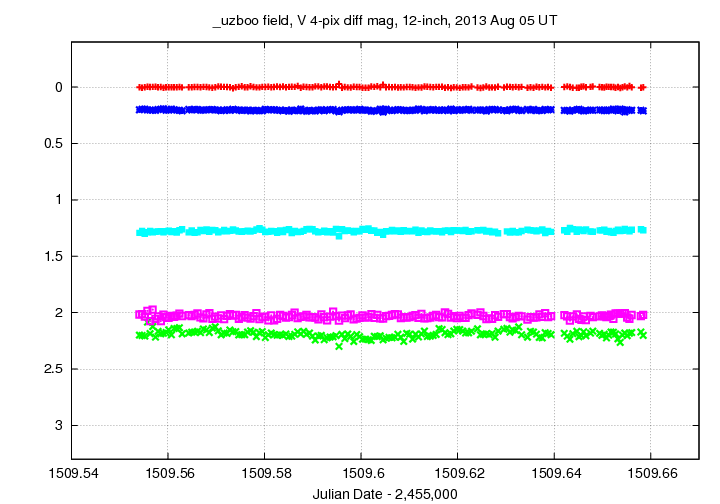
Here's a closeup of the target (green crosses) and a comparison star. As you can see, UZ Boo shows a cyclic variation with a small amplitude.
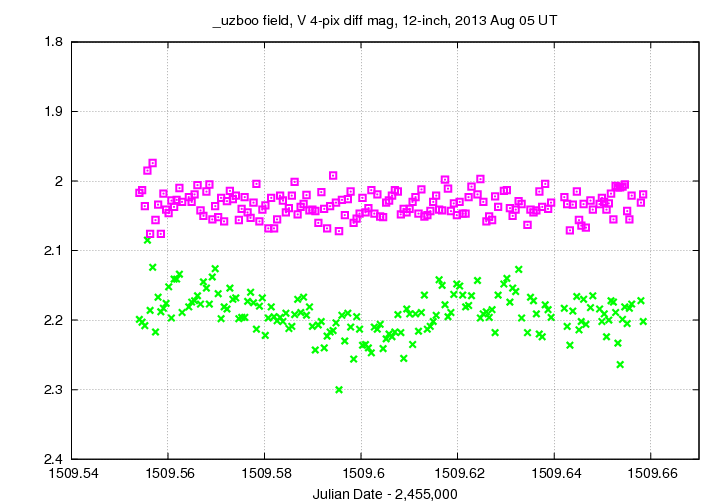
I sent a message to cba-data with the following report. This shows only the first few lines of measurements -- the full set can be retrieved using the link below.
# Measurements of UZ_Boo made at RIT Obs, Aug 5, 2013 UT, # in good conditions, # by Michael Richmond, using 12-inch Meade and SBIG ST-8E CCD. # Exposures 30 seconds long, V filter. # Tabulated times are midexposure (FITS header time - half exposure length) # and accurate only to +/- 1 second (??). # 'mag' is a differential magnitude based on ensemble photometry # using a circular aperture of radius 7.4 arcseconds. # which has been shifted so UCAC4 561-055134 has mag=11.094 # which is its V-band magnitude according to AAVSO. # # UT_day JD HJD mag uncert Aug05.05409 2456509.55409 2456509.55308 13.293 0.020 Aug05.05464 2456509.55464 2456509.55363 13.297 0.020 Aug05.05520 2456509.55520 2456509.55419 13.302 0.020 Aug05.05574 2456509.55574 2456509.55473 13.179 0.018
I took images of the Landolt standard field PG 2213-006, which contains 4 stars with very well measured magnitudes.
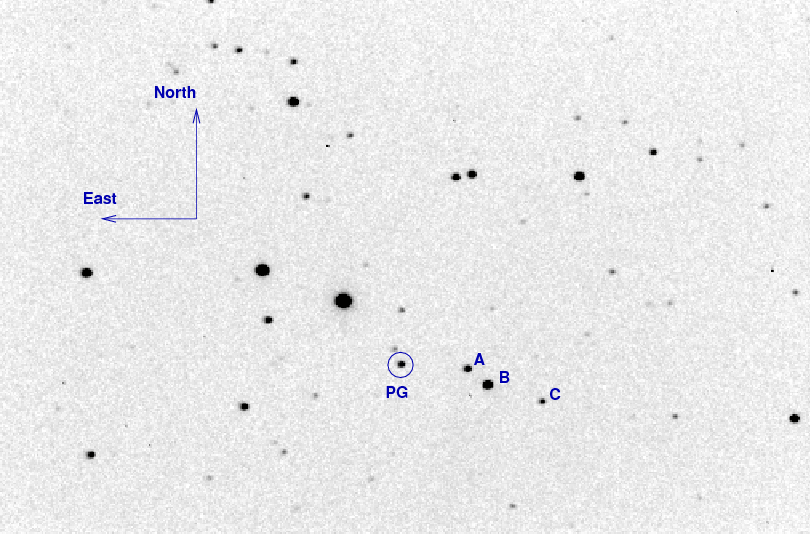
I stacked a set of 30-second exposures in each filter to create a single image with better signal-to-noise ratio, but star "C" was still so faint that its measurements were relatively noisy. I used the other three stars to determine color terms for my instrument. Combining these values with results from UT 2013 July 31 and UT 2011 Aug 27 , I end up with the following mean values:
B = b + ( 0.231 +/- 0.012 ) * (b - v) + zero_point V = v + ( -0.079 +/- 0.017 ) * (v - r) + zero_point R = r + ( -0.087 +/- 0.021 ) * (r - i) + zero_point I = i + ( -0.018 +/- 0.040 ) * (r - i) + zero_point
I will apply these values to my raw instrumental magnitudes from tonight onward.
SN 2013ej is a Type II supernova in the relatively nearby galaxy M74. It was discovered by the KAIT group some time (a week?) before maximum light. Here's a chart showing the galaxy, the SN, and some reference stars:
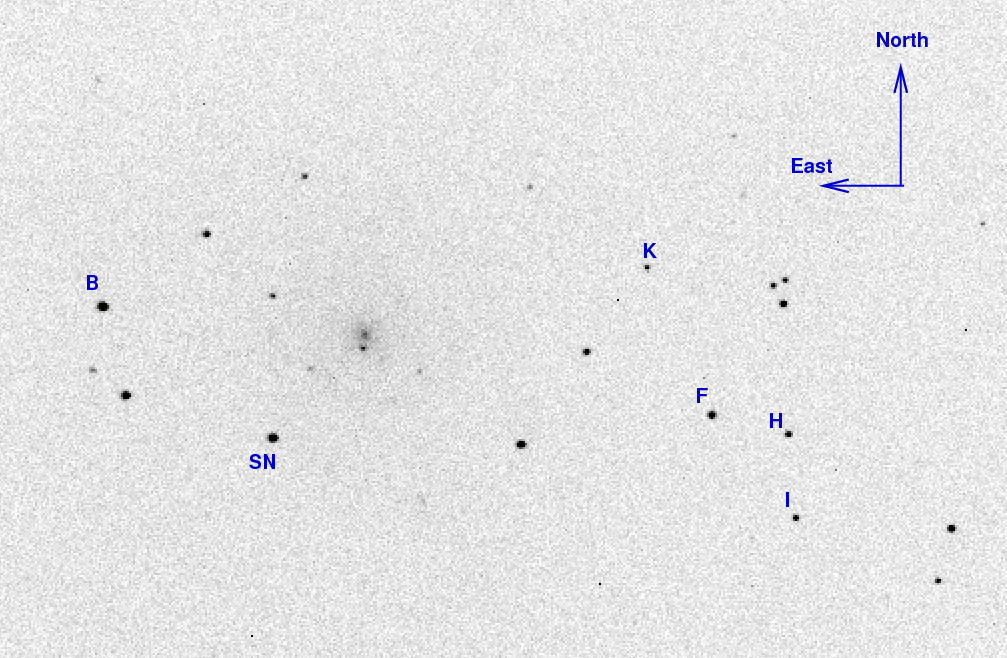
The reference stars marked above have magnitudes in AAVSO chart 12459CA, as follows:
letter B sigB V sigV R sigR I sigI B 13.012 0.019 12.510 0.019 12.154 0.019 11.834 0.019 F 13.848 0.026 13.065 0.022 12.622 0.025 12.152 0.027 H 14.338 0.029 13.692 0.024 13.329 0.029 12.964 0.030 I 14.832 0.027 13.912 0.023 13.416 0.026 12.939 0.030 K 15.192 0.034 14.613 0.027 14.275 0.034 13.915 0.036
I took 30-second guided images -- expect in B-band: the guide star was too faint for the guider to track. I ended up with 11 good images in B, 3 in V, 7 in R, 4 in I.
Using aperture photometry with a radius of 4 pixels (radius of 7.4 arcsec), I measured the instrumental magnitudes of a number of reference stars and the target. Following the procedures outlined by Kent Honeycutt's article on inhomogeneous ensemble photometry, I used all stars available in each image to define a reference frame, and measured each star against this frame. I used the AAVSO magnitudes, plus color terms -- new color terms starting tonight! -- to convert the ensemble instrumental magnitudes to the standard Johnson-Cousins BVRI scale.
Results from this morning are:
filter mag mag_uncert Julian Date B = 12.700 +/- 0.056 (ens 0.017 zp 0.053) 2456509.73858 V = 12.513 +/- 0.042 (ens 0.019 zp 0.038) 2456509.73017 R = 12.350 +/- 0.034 (ens 0.014 zp 0.031) 2456509.72638 I = 12.318 +/- 0.041 (ens 0.016 zp 0.038) 2456509.71647
The uncertainties here are about equally due to noise in the images and transforming the instrumental magnitudes to the standard scale.
Grab the text file below for all the RIT measurements of SN 2013ej. All these values have been recomputed with the new color terms of UT 2013 Aug 05.
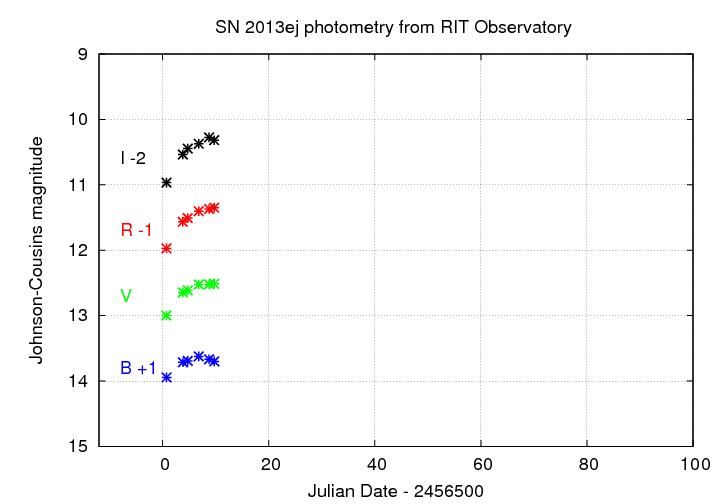
Last modified 08/05/2013 by MWR.